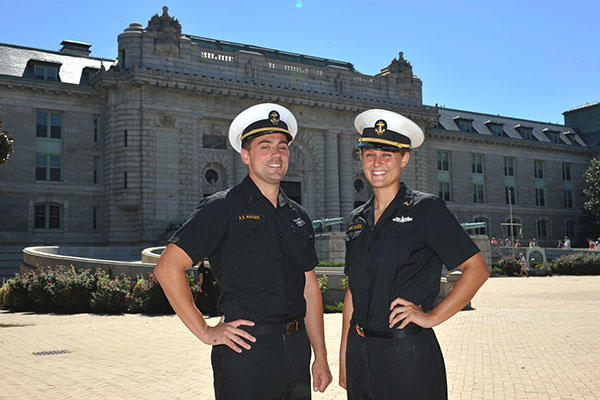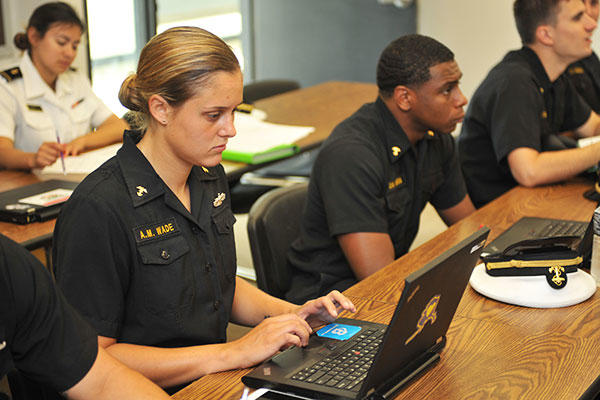ANNAPOLIS, Md. — With the recent release of ALNAV 065/15, the United States Naval Academy (USNA) is now accepting motivated Sailors and Marines, active and reserve, for admission to the Class of 2020.
Successful candidates will be top-quality Sailors and Marines with a competitive academic and military profile.
Preparation begins as early as high school. Typically, fleet applicants who ranked in the top 40 percent of their high school class are considered good candidates.
Additional requirements include SAT/ACT scores taken within the last two years, four years of high school mathematics and English and on year of chemistry. Two years of a foreign language is highly recommended.
A candidate's application can be strengthened with demonstrated strong leadership and command recognition.
Candidates must be of good moral character and have no record of disciplinary action during the three years preceding application for admission. Packages will not be reviewed without the commanding officer's endorsement.
The process of application to USNA can seem daunting while serving your country. It is highly recommended to seek out a mentor at your command, especially one who attended USNA.
Mentors can guide and help articulate why the individual wants to attend USNA in preparation for the interviews needed for the CO's endorsement, which stands in place of the nomination.
"It was definitely huge having an officer mentor help me through the process," said Midshipman First Class Andrew Whisner, a former enlisted hospital corpsman. "My executive officer was a USNA graduate, and he went as far as to help me finish the last pieces of my application that I couldn't physically do myself while I was deployed to Afghanistan. Chances are there is an academy graduate at your command."
Beyond academics and military bearing, physical fitness is a top priority at USNA.
Applicants are required to possess outstanding physical fitness, as determined by the Candidate Fitness Assessment and recent command Physical Fitness Assessments.
"Everyone is in shape here at the academy," said Midshipman First Class Anna Wade, a prior enlisted Mass Communication Specialist. "My time period before getting ready to come here was a lot of physical training. I knew I was going to be pitted against people four years younger than myself, and I knew I wanted to be in better shape than I was at the time. I would suggest to anyone to do an honest self-assessment and make the improvements you need to."
Changing from a military-focused environment to an academic-focused one can be a challenge. Applicants are encouraged to enroll in college courses in higher math and science while at their command in order to strengthen their admission application and to help them adapt to an academic environment.
"A major challenge for enlisted and reservists is transitioning back to an academic environment," said Chief Logistics Specialist Maximo Regino, coordinator for USNA Fleet Naval Academy Preparatory School (NAPS). "Often they have to attend the Naval Academy Preparatory School, and the environment of NAPS replicates that of USNA. We know these service members are out in the fleet training, performing and focused on their mission. NAPS is here to encourage the transition. I would tell potential candidates take a college-level mathematics or science course to get yourself back into the academic groove."
Up to 170 regular and reserve personnel may be appointed to USNA each year. The experience they bring to the Brigade of Midshipmen is invaluable.
"Our prior [enlisted] midshipmen provide a unique and important perspective. They are able to relate lessons from the fleet back to what they are doing here at the academy and they are able to convey those lessons to their fellow midshipmen," said Colonel Steve Liszewski, commandant of midshipmen. "One of the reasons I am a Marine today is because I had a squad leader during Plebe Summer who had been a prior enlisted Marine. His inspirational leadership and the example that he set helped guide my decision to become a Marine."
The four years at USNA are challenging in order to develop midshipmen morally, mentally and physically. For enlisted candidates who are accepted the change can be a humbling experience.
"You've been in two years, made rank and now you are coming to USNA and you're taking orders from a second year midshipman who has no [fleet] experience. It's hard for a lot of 'priors'," said Whisner. "You might have more fleet experience, but that individual has more academy experience and that's what matters here. I see people struggle with that pride. This is a very humbling place and you have to adapt or you won't make it."
The deadline to apply to the Class of 2020 is December 31, 2015. The deadline for all completed application documents is January 31, 2016. Individuals interested in applying can find a list of needed resources at www.usna.edu/Admissions/






























